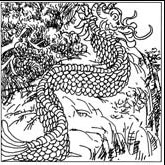Think big, be delusional
By Raymond Zhou (China Daily)Updated: 2007-04-07 07:31
 The hullabaloo about the 21-kilometer cement dragon in
Central China's Henan mostly centers on its legality: Did it go through proper
procedures before its construction?
The hullabaloo about the 21-kilometer cement dragon in
Central China's Henan mostly centers on its legality: Did it go through proper
procedures before its construction?
The local environmental protection agency said it didn't know anything about it until the project made its way into the media, as if it were a quilt stitched together behind closed doors.
While most people see the dragon as a colossal symbol of negligence, let's pause for a moment and switch sides. Think about it from the perspective of those involved in conceiving it.
It wouldn't be far-fetched to think that these people see themselves as visionaries. Li Xiong, the father of this brainchild, repeatedly compared the cement dragon to the Great Wall. "We do not fear attacks. They built the Great Wall in ancient times, and we'll build the Great Dragon today. We'll do it!" he was quoted as proclaiming.
His company's grand statement goes like this: "You are not man enough if you don't climb up the Great Wall, and we won't give up until we construct the Great Dragon!"
 About the only thing he did not say was: "I'll go down in
history as someone equally as unforgettable as the First Emperor who built the
Great Wall. People 2,000 years from now will remember my name, but if you want
that, too, you'd better pay me."
About the only thing he did not say was: "I'll go down in
history as someone equally as unforgettable as the First Emperor who built the
Great Wall. People 2,000 years from now will remember my name, but if you want
that, too, you'd better pay me."
Well, he did mention something to that effect, albeit not in such grandiloquent terms. For an undisclosed sum, you can carve your name on one of the scales, meaning a cement block, and if you represent a "dragon-head enterprise", meaning something like a Fortune 500 company or a local equivalent, you can etch its name in the 30-meter-high dragon's head, which is almost completed.
Better yet, if you are the Party secretary of a city or an Olympic champion, you get to achieve cement immortality for free. What a public service!
To beef up their credentials, the builders made claims that the dragon had won the gold award for "the great idea of innovation" in 2000.
I'm sure the First Emperor would be green with envy. To build his wall, he had to drive half a million people, 10 percent of the nation's workforce of the time, into slave labor. According to Professor Ge Jianxiong, who studied this episode of Chinese civilization, most of the laborers were castrated or tortured so cruelly that they never had any hope of returning home alive.
The most famous folk tale associated with the wall is about a housewife called Meng Jiangnu, whose husband was enlisted and died there. Meng trekked to the wall and cried and cried, until her wailing brought down a section of it.
With the whole country hating and cursing him, no wonder the Emperor died at the relatively young age of 50.
The builders of the cement dragon are proving much more ingenious. For starters, they did not conscript anyone into servitude. And they resorted to inspiring slogans such as "reviving our old civilization" and "presenting a gift on the 60th birthday of the People's Republic".
Like local government officials who are always thinking delusionally big, they are obsessed with size, but with a twist of practicality. Yes, it is a white elephant, but it can be a white elephant that generates an endless stream of revenues and profits, probably for 2,000 years for the investors and operators.
And did I mention it is built with cement, which will be artistically fashionable 2,000 years from now?
Those of you who have seen photos of the already built 800 meters of the highly unhidden dragon would marvel at the gargantuan structure. Calling it a folly would amount to whitewashing.
Latest reports say that the builders, aware that public pressure has dashed their 300-million yuan dream of delirium, have settled on a scaled-back agenda preserving what's already done. Maybe they should call it a sculpture of modern art.
Email: raymondzhou@chinadaily.com.cn
(China Daily 04/07/2007 page4)
|
|
|
|